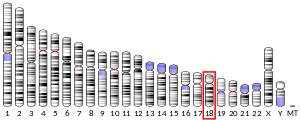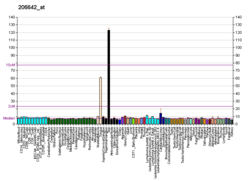Desmoglein-1
Desmoglein-1 is a protein that in humans is encoded by the DSG1 gene.[4][5] Desmoglein-1 is expressed everywhere in the skin epidermis, but mainly it is expressed in the superficial upper layers of the skin epidermis.[6]
Function
Desmosomes are cell-cell junctions between epithelial, myocardial and certain other cell types. Desmoglein-1 is a calcium-binding transmembrane glycoprotein component of desmosomes in vertebrate epithelial cells. Currently, four desmoglein subfamily members have been identified and all are members of the cadherin cell adhesion molecule superfamily. These desmoglein gene family members are located in a cluster on chromosome 18. The protein encoded by this gene has been identified as the autoantigen of the autoimmune skin blistering disease pemphigus foliaceus.[5] It has been found that Desmoglein-1 is the target antigen in majority of the cases linked to IgG/IgA pemphigus, which is an autoimmune IgG/IgA antibody mediated response.[7] Desmoglein-1 is also a target of Staphylococcus Exotoxins A and B which contribute to the pathoaetiology of Staph Scalded Skin Syndrome (SSSS).
Deficiency of the Desmoglein-1 protein has been found to be associated with increased expression of multiple genes encoding allergy-related cytokines.[8] Desmoglein-1 is haploinsufficient and a mutation in the gene can cause the autosomal dominant mutation striate palmoplantar keratoderma.[9] Recently, cases have arose where the homozygous loss of the Desmoglein-1 gene has resulted in a rare syndrome known as SAM syndrome - severe dermatitis, multiple allergies, and metabolic wasting.[10]
Interactions
Desmoglein-1 has been shown to interact with PKP3,[11] PKP2,[12] and PTPRT (PTPrho)[13]
See also
- Desmoglein
- List of target antigens in pemphigus
- List of conditions caused by problems with junctional proteins
References
- GRCh38: Ensembl release 89: ENSG00000134760 - Ensembl, May 2017
- "Human PubMed Reference:". National Center for Biotechnology Information, U.S. National Library of Medicine.
- "Mouse PubMed Reference:". National Center for Biotechnology Information, U.S. National Library of Medicine.
- Arnemann J, Spurr NK, Wheeler GN, Parker AE, Buxton RS (July 1991). "Chromosomal assignment of the human genes coding for the major proteins of the desmosome junction, desmoglein DGI (DSG), desmocollins DGII/III (DSC), desmoplakins DPI/II (DSP), and plakoglobin DPIII (JUP)". Genomics. 10 (3): 640–5. doi:10.1016/0888-7543(91)90446-L. PMID 1889810.
- "Entrez Gene: DSG1 desmoglein 1".
- Beigi, Pooya Khan Mohammad (2018). "Background". A Clinician's Guide to Pemphigus Vulgaris. Springer, Cham. pp. 3–10. doi:10.1007/978-3-319-67759-0_1. ISBN 9783319677583.
- "JDDG: Journal der Deutschen Dermatologischen Gesellschaft: Vol 4, No 7". JDDG. 4 (7). July 2006. doi:10.1111/ddg.2006.4.issue-7. ISSN 1610-0379.
- Samuelov L, Sarig O, Harmon RM, Rapaport D, Ishida-Yamamoto A, Isakov O, Koetsier JL, Gat A, Goldberg I, Bergman R, Spiegel R, Eytan O, Geller S, Peleg S, Shomron N, Goh CS, Wilson NJ, Smith FJ, Pohler E, Simpson MA, McLean WH, Irvine AD, Horowitz M, McGrath JA, Green KJ, Sprecher E (October 2013). "Desmoglein 1 deficiency results in severe dermatitis, multiple allergies and metabolic wasting". Nature Genetics. 45 (10): 1244–1248. doi:10.1038/ng.2739. PMC 3791825. PMID 23974871.
- Has C, Jakob T, He Y, Kiritsi D, Hausser I, Bruckner-Tuderman L (January 2015). "Loss of desmoglein 1 associated with palmoplantar keratoderma, dermatitis and multiple allergies". The British Journal of Dermatology. 172 (1): 257–61. doi:10.1111/bjd.13247. PMID 25041099.
- McAleer MA, Pohler E, Smith FJ, Wilson NJ, Cole C, MacGowan S, Koetsier JL, Godsel LM, Harmon RM, Gruber R, Crumrine D, Elias PM, McDermott M, Butler K, Broderick A, Sarig O, Sprecher E, Green KJ, McLean WH, Irvine AD (November 2015). "Severe dermatitis, multiple allergies, and metabolic wasting syndrome caused by a novel mutation in the N-terminal plakin domain of desmoplakin". The Journal of Allergy and Clinical Immunology. 136 (5): 1268–76. doi:10.1016/j.jaci.2015.05.002. PMC 4649901. PMID 26073755.
- Bonné S, Gilbert B, Hatzfeld M, Chen X, Green KJ, van Roy F (April 2003). "Defining desmosomal plakophilin-3 interactions". The Journal of Cell Biology. 161 (2): 403–16. doi:10.1083/jcb.200303036. PMC 2172904. PMID 12707304.
- Chen X, Bonne S, Hatzfeld M, van Roy F, Green KJ (March 2002). "Protein binding and functional characterization of plakophilin 2. Evidence for its diverse roles in desmosomes and beta -catenin signaling". The Journal of Biological Chemistry. 277 (12): 10512–22. doi:10.1074/jbc.M108765200. PMID 11790773.
- Besco JA, Hooft van Huijsduijnen R, Frostholm A, Rotter A (October 2006). "Intracellular substrates of brain-enriched receptor protein tyrosine phosphatase rho (RPTPrho/PTPRT)". Brain Research. 1116 (1): 50–7. doi:10.1016/j.brainres.2006.07.122. PMID 16973135.
Further reading
- Amagai M (February 2003). "Desmoglein as a target in autoimmunity and infection". Journal of the American Academy of Dermatology. 48 (2): 244–52. doi:10.1067/mjd.2003.7. PMID 12582396.
- Wheeler GN, Parker AE, Thomas CL, Ataliotis P, Poynter D, Arnemann J, Rutman AJ, Pidsley SC, Watt FM, Rees DA (June 1991). "Desmosomal glycoprotein DGI, a component of intercellular desmosome junctions, is related to the cadherin family of cell adhesion molecules". Proceedings of the National Academy of Sciences of the United States of America. 88 (11): 4796–800. Bibcode:1991PNAS...88.4796W. doi:10.1073/pnas.88.11.4796. PMC 51753. PMID 1711210.
- Amagai M, Klaus-Kovtun V, Stanley JR (November 1991). "Autoantibodies against a novel epithelial cadherin in pemphigus vulgaris, a disease of cell adhesion". Cell. 67 (5): 869–77. doi:10.1016/0092-8674(91)90360-B. PMID 1720352.
- Martínez RD (1992). "[Characterization of the desmoglein in renal cells in culture]" [Characterization of the desmoglein in renal cells in culture]. Revista Alergia Mexico (in Spanish). 38 (2): 59–64. PMID 1754823.
- Nilles LA, Parry DA, Powers EE, Angst BD, Wagner RM, Green KJ (August 1991). "Structural analysis and expression of human desmoglein: a cadherin-like component of the desmosome". Journal of Cell Science. 99 ( Pt 4) (4): 809–21. PMID 1770008.
- Roh JY, Stanley JR (May 1995). "Plakoglobin binding by human Dsg3 (pemphigus vulgaris antigen) in keratinocytes requires the cadherin-like intracytoplasmic segment". The Journal of Investigative Dermatology. 104 (5): 720–4. doi:10.1111/1523-1747.ep12606963. PMID 7738346.
- Simrak D, Cowley CM, Buxton RS, Arnemann J (January 1995). "Tandem arrangement of the closely linked desmoglein genes on human chromosome 18". Genomics. 25 (2): 591–4. doi:10.1016/0888-7543(95)80067-V. PMID 7790000.
- Wang Y, Amagai M, Minoshima S, Sakai K, Green KJ, Nishikawa T, Shimizu N (April 1994). "The human genes for desmogleins (DSG1 and DSG3) are located in a small region on chromosome 18q12". Genomics. 20 (3): 492–5. doi:10.1006/geno.1994.1207. PMID 8034325.
- Schäfer S, Koch PJ, Franke WW (April 1994). "Identification of the ubiquitous human desmoglein, Dsg2, and the expression catalogue of the desmoglein subfamily of desmosomal cadherins". Experimental Cell Research. 211 (2): 391–9. doi:10.1006/excr.1994.1103. PMID 8143788.
- Adams MJ, Reichel MB, King IA, Marsden MD, Greenwood MD, Thirlwell H, Arnemann J, Buxton RS, Ali RR (January 1998). "Characterization of the regulatory regions in the human desmoglein genes encoding the pemphigus foliaceous and pemphigus vulgaris antigens". The Biochemical Journal. 329 ( Pt 1) (Pt 1): 165–74. doi:10.1042/bj3290165. PMC 1219028. PMID 9405290.
- Marcozzi C, Burdett ID, Buxton RS, Magee AI (February 1998). "Coexpression of both types of desmosomal cadherin and plakoglobin confers strong intercellular adhesion". Journal of Cell Science. 111 ( Pt 4) (4): 495–509. PMID 9443898.
- Smith EA, Fuchs E (June 1998). "Defining the interactions between intermediate filaments and desmosomes". The Journal of Cell Biology. 141 (5): 1229–41. doi:10.1083/jcb.141.5.1229. PMC 2137181. PMID 9606214.
- Rickman L, Simrak D, Stevens HP, Hunt DM, King IA, Bryant SP, Eady RA, Leigh IM, Arnemann J, Magee AI, Kelsell DP, Buxton RS (June 1999). "N-terminal deletion in a desmosomal cadherin causes the autosomal dominant skin disease striate palmoplantar keratoderma". Human Molecular Genetics. 8 (6): 971–6. doi:10.1093/hmg/8.6.971. PMID 10332028.
- Li G, Schaider H, Satyamoorthy K, Hanakawa Y, Hashimoto K, Herlyn M (December 2001). "Downregulation of E-cadherin and Desmoglein 1 by autocrine hepatocyte growth factor during melanoma development". Oncogene. 20 (56): 8125–35. doi:10.1038/sj.onc.1205034. PMID 11781826.
- Chen X, Bonne S, Hatzfeld M, van Roy F, Green KJ (March 2002). "Protein binding and functional characterization of plakophilin 2. Evidence for its diverse roles in desmosomes and beta -catenin signaling". The Journal of Biological Chemistry. 277 (12): 10512–22. doi:10.1074/jbc.M108765200. PMID 11790773.
- Martel P, Gilbert D, Busson M, Loiseau P, Lepage V, Drouot L, Delaporte E, Prost C, Joly P, Charron D, Tron F (June 2002). "Epistasis between DSG1 and HLA class II genes in pemphigus foliaceus". Genes and Immunity. 3 (4): 205–10. doi:10.1038/sj.gene.6363839. PMID 12058255.
- Hanakawa Y, Schechter NM, Lin C, Garza L, Li H, Yamaguchi T, Fudaba Y, Nishifuji K, Sugai M, Amagai M, Stanley JR (July 2002). "Molecular mechanisms of blister formation in bullous impetigo and staphylococcal scalded skin syndrome". The Journal of Clinical Investigation. 110 (1): 53–60. doi:10.1172/JCI15766. PMC 151035. PMID 12093888.
- Hanakawa Y, Amagai M, Shirakata Y, Yahata Y, Tokumaru S, Yamasaki K, Tohyama M, Sayama K, Hashimoto K (December 2002). "Differential effects of desmoglein 1 and desmoglein 3 on desmosome formation". The Journal of Investigative Dermatology. 119 (6): 1231–6. doi:10.1046/j.1523-1747.2002.19648.x. PMID 12485422.


